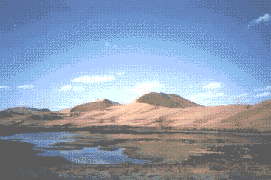
USA
News:
In August, 1995 the China-Japan Joint Research Group formed by the Institute
of Desert Research, Chinese Academy of Sciences and Amino-town (Kyoto Pref.
) discovered many active booming dunes in a closed military base in the
Badain-jaram desert. Details of the dunes and their loud sounding and self-booming
activity were ascertained. The restricted access maintained a clean environment
in harmony with the living structure of the desert which was constructed
by the coexistence of sand, camels and human beings.
The booming sands of the desert and the singing sands on beachs face the
same danger from human destruction of the environment. We need some means
to monitor the situation. An unexpected finding was reported which hints
at how to make clear booming sand formations from beach sand . From the
similarity of both sands, it was proposed to cooperate and construct data
making stations on both sites.
Because the desert is in an area remote from the main Silk-road (Fig.1)
and only about 30 Mongolian nomad families with camels are living there
now (over 250km from east to west), the environment has remained untouched.
Fig-1: Badain-jaran desert
There are no roads into the desert and the routes are bumpy. We cannot go
to the place without camels. The point surveyed was Bojitoleganor lake district
shown in Fig.2 .
 Fig-2: Aproach
to booming test point
Fig-2: Aproach
to booming test point
In the district we tried booming-tests with about 10 men, climbing 50m high
and sliding down the slope. We tested at the three points ( Fig.3 ). Each area
has a small lake, and the dominate wind direction in the district is from west
to east. The temperature of the sand was 65 C .

Fig-3: Three booming dunes tested
Booming tests and self booming
the above three point had almost the same booming character. After several
seconds of sliding, great booming sounds occured (60-70dB) and continued
until the men stopped at the foot of the slope. If the men stopped in the
middle of the slope, the surface layer of the sand would countinue avalanching
by itself and boom continuously for several minutes. The slope angle was
31 degree, total slide length on the slope was about 100m. The sound was
large enough to hear from a distance of 4 Km or more. The highest sound
level was found at the 2nd point. We picked up a sample of the sand at a
midpoint of the slope.
In the evening strong winds made the sand slid down the dune slope, producing
booming by itself. We heard the self-booming every evening from 4 Km away
during our 3 day stay at the place.
The dunes have complete booming activity and they can groan without any
human intervention. The fact that the sands shown in Fig.4 have such activity
is clear evidence that keeping a genuine environmental condition over the
desert is essential. All had very low frequency soundings (about 100Hz)
and are rare examples of a complete self-purification and harmony
between natural sand dunes, the life of nomads and their camels.
 Fig-4: Microphotograph
of the sand
Fig-4: Microphotograph
of the sand